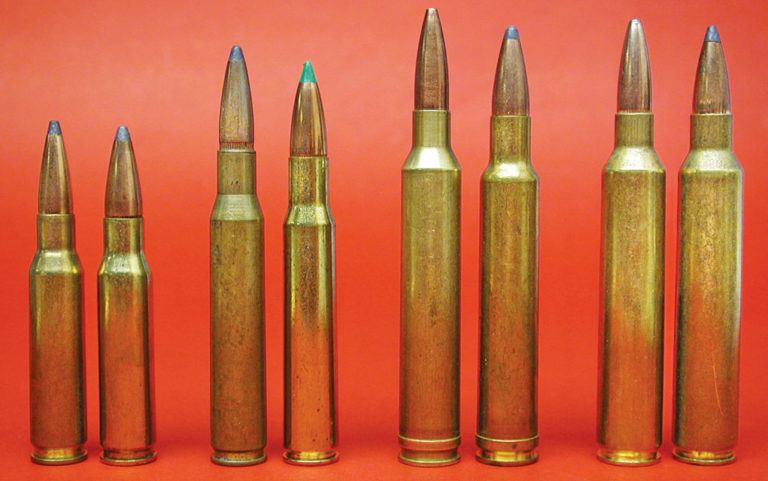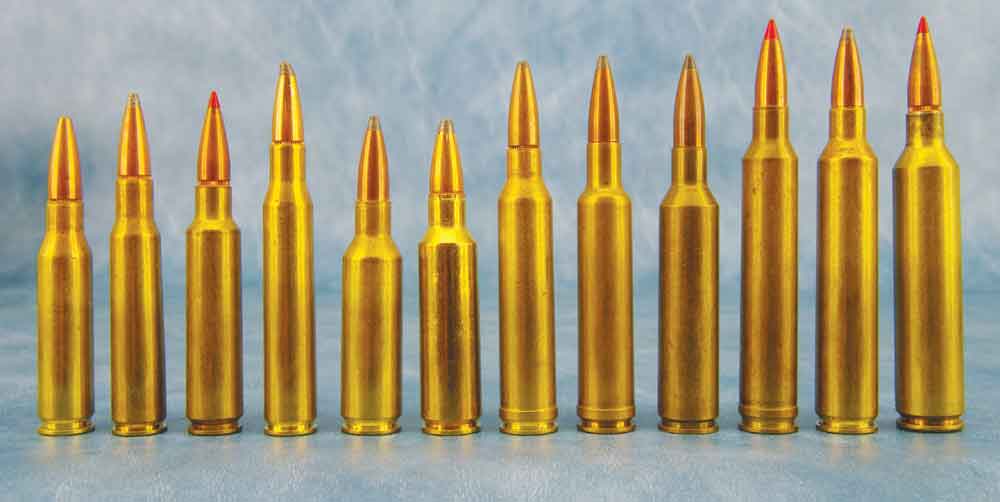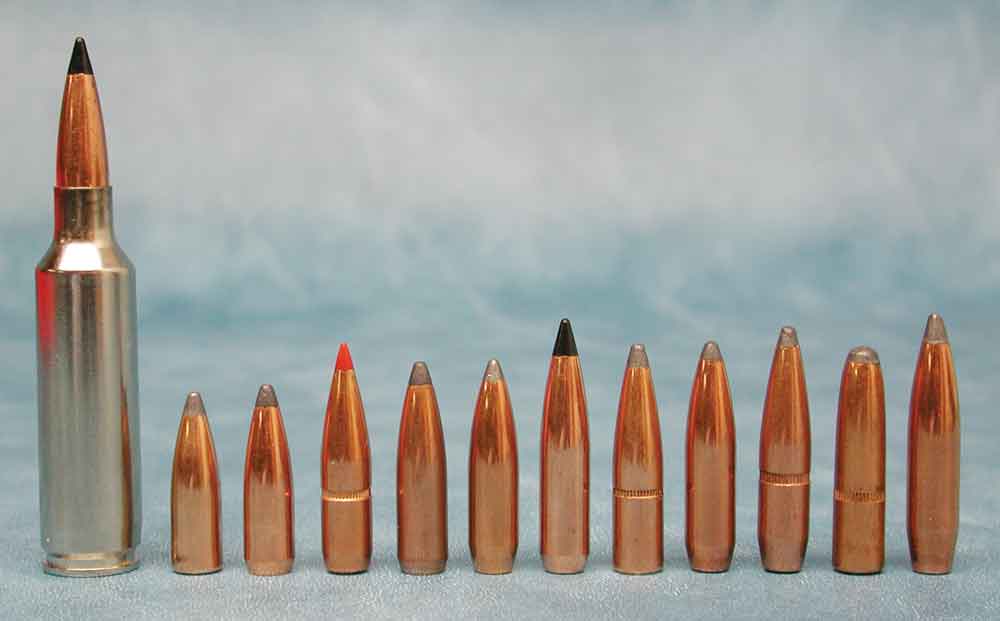
Which is superior in the 7mm vs .30 caliber argument? One veteran gunwriter weighs in on the subject.
In the 7mm vs 30 caliber debate, which reigns supreme?
- Any .30-caliber cartridge delivers more energy than a comparable 7mm cartridge.
- However, this increase in energy comes with an increase in recoil.
- The increase in recoil can be as much as 30 percent, according to the author.
- The author also feels there are more bullet weights offered with the 7mm than the .30.
- Both will get the job done in appropriate applications and with good shot placement.
There was a time when there was little argument among America’s hunters about calibers. For deer hunters it was the .30-30, and for larger game it was the .30-06. Oh there were other calibers to be sure—like the .270 Winchester that emerged in 1925 — but there’s no question that the .30 caliber dominated from the turn of the last century to the mid-1960s.
Today the .30 can still be called “America’s caliber,” but it is being seriously challenged by that upstart metric, the 7mm. It all started in 1957 when Remington introduced the .280, a cartridge they hoped would sway those prospective buyers contemplating either the .270 or .30-06.

It wasn’t that the .284 bore was unheard of on these shores at the time. The 7×57 had been around since 1892 and had been adopted as the martial cartridge by nine foreign countries. And it had been chambered for sporadically here in America, most notably by Winchester in its iconic Model 70.
 But by and large the 7mm was still considered a “foreign” caliber. While the .280 could in no way be considered a commercial success even today, it did pave the way for the 7mm Remington Magnum that was to emerge five years later in 1962. Since then there have been more 7mm commercial and proprietary cartridges introduced than any other caliber.
But by and large the 7mm was still considered a “foreign” caliber. While the .280 could in no way be considered a commercial success even today, it did pave the way for the 7mm Remington Magnum that was to emerge five years later in 1962. Since then there have been more 7mm commercial and proprietary cartridges introduced than any other caliber.
I acquired my first 7mm in 1965, and over the half-century since, it’s been my caliber of choice for everything but Cape buffalo, lion and elephant. I’ve taken game on five continents using just about every commercial 7mm, from the 7×57 to Remington’s Ultra Mag., as well as several proprietary and wildcat cartridges, so I can speak with some authority on the subject.
It’s not that I haven’t had experience using other calibers. I have. I’ve been on many industry hunts, both here and abroad where I didn’t have the option to bring my own rifle or choose a specific cartridge. On most of those occasions I was handed a .30-06 or a .300 magnum, and every time it performed just as well as any 7mm I could have used.

And why wouldn’t it? It’s indisputable that a .30 caliber delivers more energy than a comparable 7mm. I’m talking 7mm-08 vs. .308; .280 Rem. vs. .30-06; 7mm STW vs. .300 Wby.; 7mm Ultra Mag. vs. .300 Ultra Mag. That’s not the point, or at least it shouldn’t be whenever one hears the 7mm vs 30 caliber argument. The only logical reason for choosing a .28 caliber over a .30 has to do with the question of how much ballistic performance you need to get the job done, and what you are willing to pay for it in terms of recoil.
Again, from a purely ballistic standpoint, everything the 7mm can do the .30 can do better. By “better” I mean a bigger hole and more energy delivered, all other things equal.
If you push a .308 bullet of comparable sectional density and ballistic coefficient over the same trajectory as a .284, it will arrive with about 15 percent more energy. But doing so generates almost 30 percent more recoil, assuming rifles of equal weight.
Now there are many who feel that an extra 15 percent is worth it. I don’t. With a magnum 7mm of one variety or another I’ve shot from every conceivable field position, many times from prone, with the toe of the butt on the ground and with just the bony top of my shoulder backing the gun up. In such a position there’s a tendency to crawl up on the scope, yet in 50 years I’ve never suffered a magnum eyebrow. I can’t say the same for several .300 magnum guys I’ve shared camps with or witnessed shooting.
 An experienced hunter who shoots often and year round won’t have an issue with shooting a .300 magnum, even off the bench where 27 to 28 ft.-lbs. of recoil can be … well, less than fun. But for the average hunter, that’s a lot of recoil — enough to affect one’s ability to shoot the gun up to its accuracy potential.
An experienced hunter who shoots often and year round won’t have an issue with shooting a .300 magnum, even off the bench where 27 to 28 ft.-lbs. of recoil can be … well, less than fun. But for the average hunter, that’s a lot of recoil — enough to affect one’s ability to shoot the gun up to its accuracy potential.
To back up that statement, all one has to do is look at competition shooting. Regardless of the specific discipline, whether it’s benchrest at 100 yards or F-Class at 1,000 yards, every shooter will be using the heaviest rifle the rules allow with a cartridge that gets the job done with the least amount of recoil.
There are those who contend that a .30 caliber simply provides more margin of error in case of a poor shot. If we’re talking strictly in terms of the theoretical, one might make a case for the .30, but in the real world that’s pure bull-pucky. A bad shot with a .30 is no better than a bad shot with a 7mm. Period.
 Another thing I particularly like is the fact that, for the handloader, there are more bullet weights offered in 7mm than in .30. Consider: among the various manufacturers, handloaders can choose 7mm bullets of 100, 110, 115, 120, 125, 130, 139, 140, 145, 150, 154, 160, 162, 168, 170 and 175 grains. If you’ve got a particularly finicky rifle with regard to its shooting a specific bullet weight better than others, you’ve a better chance of finding it if you’ve got a .284-inch hole in the barrel.
Another thing I particularly like is the fact that, for the handloader, there are more bullet weights offered in 7mm than in .30. Consider: among the various manufacturers, handloaders can choose 7mm bullets of 100, 110, 115, 120, 125, 130, 139, 140, 145, 150, 154, 160, 162, 168, 170 and 175 grains. If you’ve got a particularly finicky rifle with regard to its shooting a specific bullet weight better than others, you’ve a better chance of finding it if you’ve got a .284-inch hole in the barrel.
I guess what I’m trying to say is that, based on my experiences over the half century I’ve been hunting, I’ve never been disappointed or felt the need for anything larger than a 7mm. Regardless of where I’ve hunted — from Alaska to Zambia, South Africa to Siberia, the South Pacific to the Arctic Ocean — there’s been a 7mm in my hands. And I’m talking about hunting the world’s largest non-dangerous game: eland, zebra, gemsbok, kudu, roan, sable, elk, red deer … you name it. And whenever I feel I need something more potent than a 7mm, I want something a lot more potent, like a .375 or a .416.
Editor's Note: This article is an excerpt from the May 2015 issue of Gun Digest the Magazine.

Next Step: Get your FREE Printable Target Pack
Enhance your shooting precision with our 62 MOA Targets, perfect for rifles and handguns. Crafted in collaboration with Storm Tactical for accuracy and versatility.
Subscribe to the Gun Digest email newsletter and get your downloadable target pack sent straight to your inbox. Stay updated with the latest firearms info in the industry.

![Best Concealed Carry Guns In 2025 [Field Tested] Wilson Combat EDC X9S 1](https://gundigest.com/wp-content/uploads/Wilson-Combat-EDC-X9S-1-324x160.jpg)


![Best 9mm Carbine: Affordable PCCs [Tested] Ruger Carbine Shooting](https://gundigest.com/wp-content/uploads/Ruger-Carbine-Shooting-100x70.jpg)
![Best AR-15: Top Options Available Today [Field Tested] Harrington and Richardson PSA XM177E2 feature](https://gundigest.com/wp-content/uploads/Harrington-and-Richardson-PSA-XM177E2-feature-100x70.jpg)

Dead is dead. Harvested quarry would not notice nor discern what it was that hit them.
Kamoja Bell killed a ‘whole passel’ of elephants with a .275 Rigby – known the rest of the world as the 7×57 Mauser. It will certain serve for any North American game other than perhaps the large, dangerous bears.
At the same time, various .30 calibers (.30 WCF, .30-06 Springfield, .300 Savage and .308 Winchester) have done for the same critters pretty well.
For all practical intents and purposes, I consider them equal in results and purpose. I think I prefer the .30 caliber, but I’m not sure if I could fully explain my reasoning. I expect I heard about and had a .30-06 first.
However, I am not a fan of belted magnums in any caliber. If I want a rimmed cartridge, I have several of them from which to select.